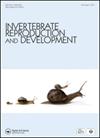Developmental inhibitory effect of the Syzygium aromaticum essential oil on the postembryonic stages of a polyphagous pest, Pericallia ricini (Lepidoptera: Arctiidae)
IF 0.8
4区 生物学
Q4 REPRODUCTIVE BIOLOGY
引用次数: 2
Abstract
ABSTRACT The chemical composition of Syzygium aromaticum essential oil (EO), and its efficacy on the development and metamorphosis of polyphagous pest, Pericallia ricini was assessed. The chemical composition of the S. aromaticum EO was analysed by gas chromatography and mass spectrometry method. The major volatile components present in the EO were eugenol, β-caryophyllene, caryophyllenyl alcohol, α-humulene, clovene, globulol, and eugenyl acetate. For topical bioassay, EO was tested against the sixth (penultimate) and seventh (ultimate) larval instars of P. ricini resulted in the disruption of normal moulting and metamorphosis, leading to various developmental aberrations. The results comprised larval mortality, delayed larval-larval, and larval-pupal ecdysis duration, ecdysial failure, formation of non-viable intermediates, emergence of abnormal adults, reduced pupation, and inhibition of total adult emergence. This study also reports about the juvenoid nature of clove oil for the first time. Our finding demonstrates that S. aromaticum EO has significant negative effects on P. ricini, and suggests that it can be implemented for the successful control of this economically important insect.Syzygium芳香精油对多食性害虫Pericallia ricini(鳞翅目:Arctidae)胚胎后阶段的发育抑制作用
摘要研究了香薷精油(EO)的化学成分及其对多食害虫蓖麻周甲(Pericallia ricini)发育和变态的抑制作用。采用气相色谱法和质谱法分析了香茅精油的化学成分。主要挥发性成分为丁香酚、β-石竹烯、石竹烯醇、α-葎草烯、丁香烯、丁香酚和丁香乙酸酯。在局部生物试验中,对蓖麻杆菌第6(倒数第二)和第7(倒数第七)幼虫进行了EO测试,结果显示EO破坏了正常的蜕皮和变态,导致各种发育异常。结果包括幼虫死亡率、幼虫-幼虫延迟、幼虫-蛹蜕皮时间、蜕皮失败、无活力中间体的形成、异常成虫的羽化、减少的化蛹和抑制全部成虫的羽化。本研究也首次报道了丁香油的幼体性质。本研究结果表明,S. aromaticum EO对蓖麻毒素有显著的负作用,可以成功地防治这种重要的经济昆虫。
本文章由计算机程序翻译,如有差异,请以英文原文为准。
求助全文
约1分钟内获得全文
求助全文
来源期刊
CiteScore
1.90
自引率
0.00%
发文量
21
审稿时长
>12 weeks
期刊介绍:
Invertebrate Reproduction & Development ( IRD) presents original research on the reproductive and developmental biology of the Invertebrata, both embryonic and postembryonic. IRD welcomes papers reporting significant results obtained using new techniques. Encouraged topic areas include: aquaculture, physiology, biochemistry, functional morphology, phylogeny, behavioural and regulatory mechanisms, including genetic, endocrine and molecular studies. Papers containing qualitative descriptions of reproductive cycles and gametogenesis will not be considered. IRD is published in association with the International Society of Invertebrate Reproduction and Development.

 求助内容:
求助内容: 应助结果提醒方式:
应助结果提醒方式:


